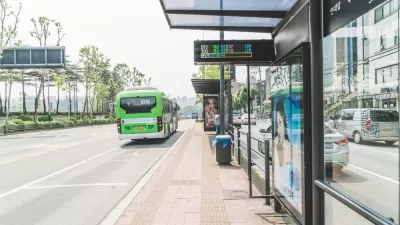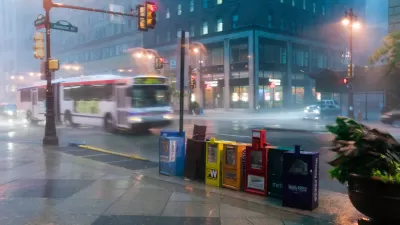Seoul simplified its routes and kept its key bus lanes clear of traffic to revitalize it's transit system.

The current ridership woes of cities in the United States are not unique in history, and American cities would do well to learn from the example of Seoul, Andy Furillo writes for Mobility Labs. "In 2002, average bus loads were less than half what they were in 1989. Private operators were going bankrupt, and the government subsidies required to keep remaining bus services running had multiplied by 10 in just three years," Furillo reports.
But rather than cutting transit, the city sought to improve the bus service. Making routes simpler—adding branch systems, regulating bus operators so they couldn't offer redundant routes and investing in a massive public information campaign. The city's mayor, Lee Myung-bak, "personally attended nearly 30 briefings for Seoul’s 16,000 bus drivers to emphasize his plans to protect their rights, increase their wages, and improve their workplace environment, helping ensure the labor community was on board with the reforms," Furillo writes.
Seoul also invested in keeping its bus lanes clear of other traffic. "On some corridors, bus speeds doubled almost immediately after the overhaul, and travel times improved for cars as well," Furillo reports. Unsurprisingly, faster buses led to ridership growth that continued even after the overhaul was a year old.
FULL STORY: What American cities can learn from Seoul’s 2004 bus redesign

Alabama: Trump Terminates Settlements for Black Communities Harmed By Raw Sewage
Trump deemed the landmark civil rights agreement “illegal DEI and environmental justice policy.”

Planetizen Federal Action Tracker
A weekly monitor of how Trump’s orders and actions are impacting planners and planning in America.

The 120 Year Old Tiny Home Villages That Sheltered San Francisco’s Earthquake Refugees
More than a century ago, San Francisco mobilized to house thousands of residents displaced by the 1906 earthquake. Could their strategy offer a model for the present?

Opinion: California’s SB 79 Would Improve Housing Affordability and Transit Access
A proposed bill would legalize transit-oriented development statewide.

Record Temperatures Prompt Push for Environmental Justice Bills
Nevada legislators are proposing laws that would mandate heat mitigation measures to protect residents from the impacts of extreme heat.

Downtown Pittsburgh Set to Gain 1,300 New Housing Units
Pittsburgh’s office buildings, many of which date back to the early 20th century, are prime candidates for conversion to housing.
Urban Design for Planners 1: Software Tools
This six-course series explores essential urban design concepts using open source software and equips planners with the tools they need to participate fully in the urban design process.
Planning for Universal Design
Learn the tools for implementing Universal Design in planning regulations.
Clanton & Associates, Inc.
Jessamine County Fiscal Court
Institute for Housing and Urban Development Studies (IHS)
City of Grandview
Harvard GSD Executive Education
Toledo-Lucas County Plan Commissions
Salt Lake City
NYU Wagner Graduate School of Public Service





























